Now that it is October, our thoughts naturally turn to USS Constitution‘s up-coming “birthday.” In honor of her 220th anniversary on the 21st of this month, we take this opportunity to look at the ship’s homeward bound trip to Boston 120 years ago.
On September 21, 1897 USS Constitution returned to Boston a month before the 100th anniversary of her launch. The ship’s storied, 83-year career, which included 33 captures and a voyage around the world, ended with her last sail (as a U.S. Navy training vessel) on October 2, 1881.
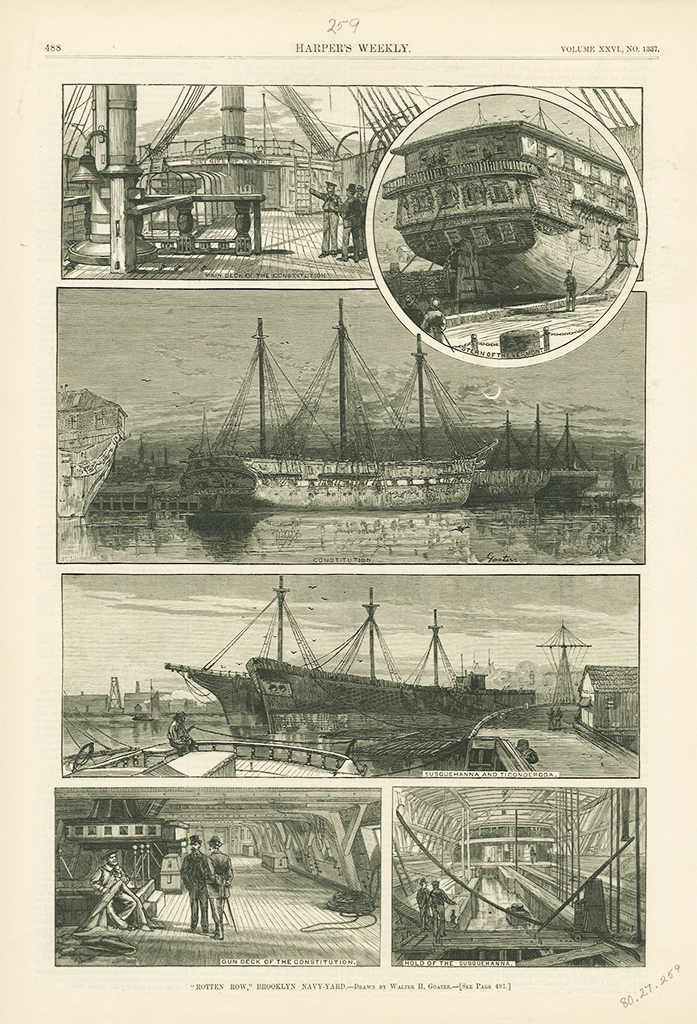
That December, “Old Ironsides”
…was formally put out of commission at the Brooklyn Navy Yard [on December 15], when her ensign was hauled down in the presence of all the officers of the yard. [“‘OLD IRONSIDES’ RETIRED, The New York Times, December 16, 1881]
A year later in October 1882, Constitution was berthed at the Portsmouth Naval Shipyard in Kittery, Maine. Her new home was at the end of Wharf 2 with the hulking Santee and Alabama shiphouses in the background. In late 1882 or early 1883, “Old Ironsides” was housed over with a large barn-like structure. In the Annual Report of the Secretary of the Navy for the Year 1888, the ship is listed under “Receiving Ships” and her condition as “In Ordinary”. Her glory days were long over.
“Ships in Ordinary, are those, which, being laid up, are under the direction of the commissioners at the…ports.” [Falconer’s New Universal Dictionary of the Marine, 1815]
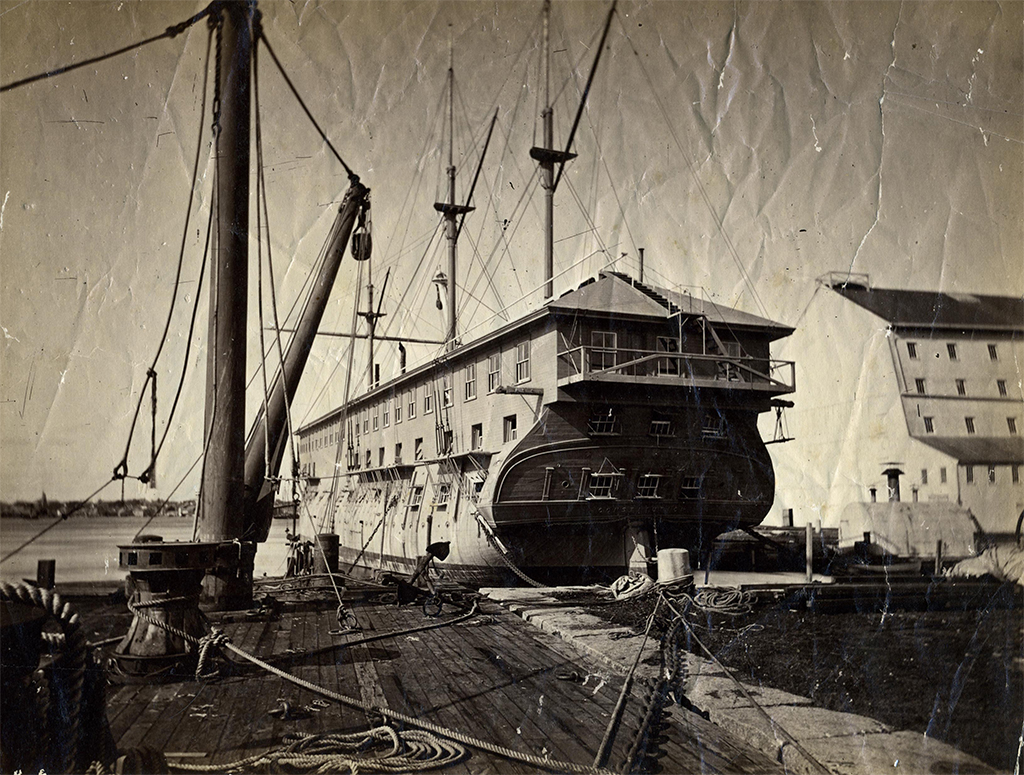
USS Constitution‘s receiving ship career was relatively uneventful. She continued to attract attention and visitors were permitted to wander her decks and imagine life and battle at sea in the War of 1812. Displays of artifacts were put aboard for special occasions. One such event was the April 30, 1891, “Grand Reception and Colonial Party” hosted by the Grand Army of the Republic, Storer Post No. 1 to commemorate the 30th anniversary of the fall of Fort Sumter and the start of the American Civil War.


One of the more unusual objects on display was
“…Gunner [Richard] Dunn’s wooden leg, one of the treasured relics of [the Portsmouth Navy Yard], where its owner was stationed after he lost his own leg on board the Constitution in her memorable fight with the Guerriere.” [The Portsmouth Journal, May 9, 1891]
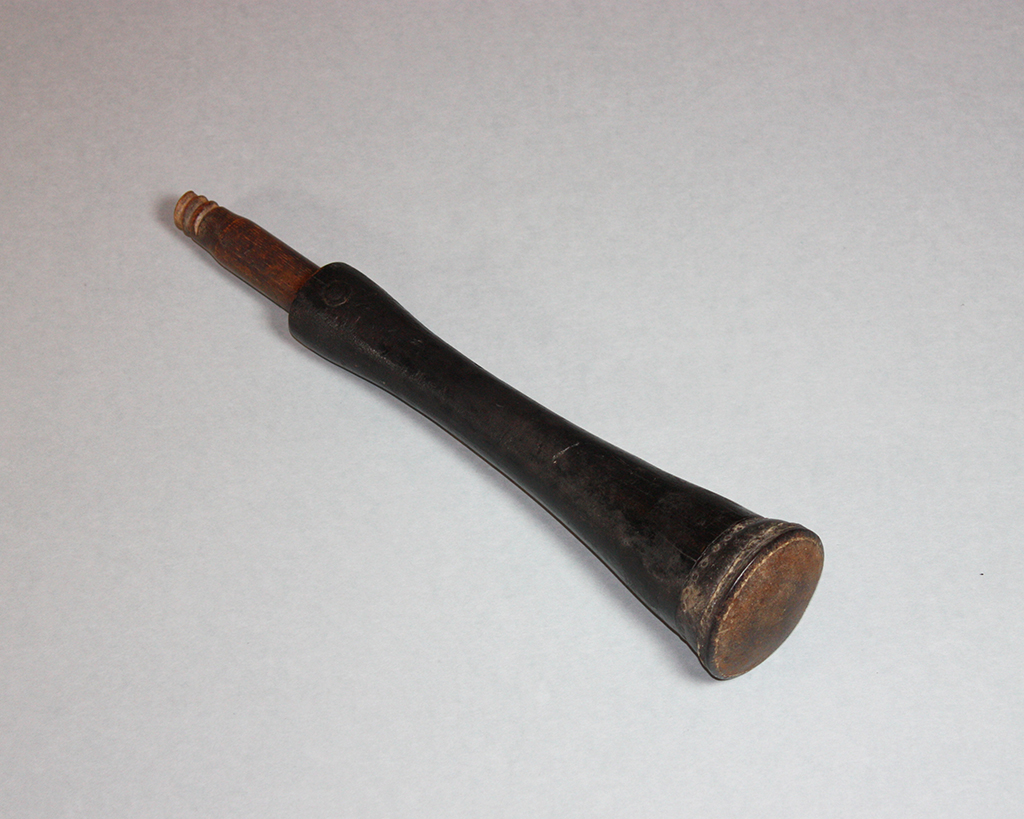
One year later however, the shipkeepers found it necessary to lock the entrance door to Constitution for
“…[u]ntil recently the door was open to the public but Commandant C.C. Carpenter [of the Portsmouth Naval Shipyard] ordered it kept locked and it is now necessary to get a pass from headquarters to go aboard. This course was found necessary in order to preserve the vessel as ‘relic cranks’ were fast ‘cutting the vessel up.’ Unknown parties have gone aboard and carried away parts of the ship and with tools have removed several valuable historic parts…A prominent officer of the yard remarked to the writer today, ‘If we did not watch the vessel there would be nothing left of her in five years above the water line.'” [“OLD IRONSIDES. A Visit to the Old Ship Constitution,” Manchester Union, December 24, 1892]
Little maintenance was done to Constitution while she was at the Portsmouth Yard and occasionally reports would go out that the ship was leaking so badly that she was in danger of sinking.
“A few days ago an article went the rounds of the newspapers to the effect that ‘Old Ironsides’ was in a sinking condition and The Union reporter at once boarded the government ferry 132 for the navy yard to make enquiries about the historic old vessel and take a last look at her, but found at once that there was little truth in the story. The remains of the unconquerable old-man-of-war vessel are in a bad condition but there is no immediate danger of her sinking….The writer found everything neat and tidy aboard the vessel and one might imagine himself in a large building instead of being aboard a ship…There are no signs of the vessel decaying and today she looks as if she could hold her own in a battle of modern man-of-war vessels….Shipkeeper Stevens…in speaking of the condition of the frigate…said, ‘She now leaks ten inches in twenty-four hours and this keeps increasing. The vessel was [dry] docked about a year ago and had her bottom scraped and repaired. With slight repairs to her bottom she could be preserved for many years, and in her present condition she would stand several years.'” [“OLD IRONSIDES. A Visit to the Old Ship Constitution,” Manchester Union, December 24, 1892]
The Manchester Union reporter was a bit optimistic in his assessment of the hero of the War of 1812. The shipkeeper’s warning that the leaks would increase was realized when this notice appeared in 1896:
“It is given out that the historic U.S. frigate Constitution is leaking at the rate of forty-two inches per twenty-four hours and that the daily leak has increased ten inches in one week. The venerable and venerated vessel is quietly passing away her years, at very little cost for preservation, as is indicated by the fact that the total amount paid out on her last year for repairs…was only $10.64. A movement is now on foot to have her thoroughly repaired and taken to Washington by next year, which will be the 100th anniversary of launching…” [The Portsmouth Journal, “Around Home”, August 1, 1896]
As we discussed in the post “John F. Kennedy and ‘Old Ironsides'”, it was President Kennedy’s grandfather, John F. (“Honey Fitz”) Fitzgerald, along with other Boston and Massachusetts politicians and constituents who won the day to have USS Constitution returned to her native city. Preparations to move the ship to Boston began in the summer of 1897, when she was hauled July 19-21 in the Portsmouth Navy Yard’s balanced floating dry dock.
“The Balance Dock…may be described in general terms as a combination of the Caisson and Camel [external floatation tank], united in the form of a walled Dock, having a middle compartment in which the vessel rests, after the water is pumped out… This combination is made by butting the side compartments, or balancing chambers, with sloping inner walls, into a Caisson…Such, in general terms, is the Balance Dock, so designated from the facility of preserving an exact equilibrium and level by means of water let into, or pumped out, the separate compartments of either of the side chambers…[which] all communicat[e] with the pump-wells in the centre of the chamber by means of valves. The power, therefore, of preserving the level of the Dock, both transversely and longitudinally, as it rises with its load, is ample.” [The Naval Dry Docks of the United States by Charles B. Stuart, 1852]
Recently, our colleague, Joseph Gluckert, historian for the Portsmouth Naval Shipyard, found three glass-plate negatives that were new to us and our research into USS Constitution. The first photograph (below) is a head-on image of Portsmouth’s balanced floating dry dock. The 350-foot wooden dock was completed in 1851, and operated at Portsmouth from 1852 to 1906. Note the caisson in place at the foot of the dock, keeping out the waters of the Piscataqua River. A marine railway, at the head of the dock, was used to haul a vessel from the dock onto solid ground, if necessary. USS Constitution first entered this dock for her 1857-1858 rebuilding and was hauled onto the marine railway for below-the-waterline work on her copper sheathing.
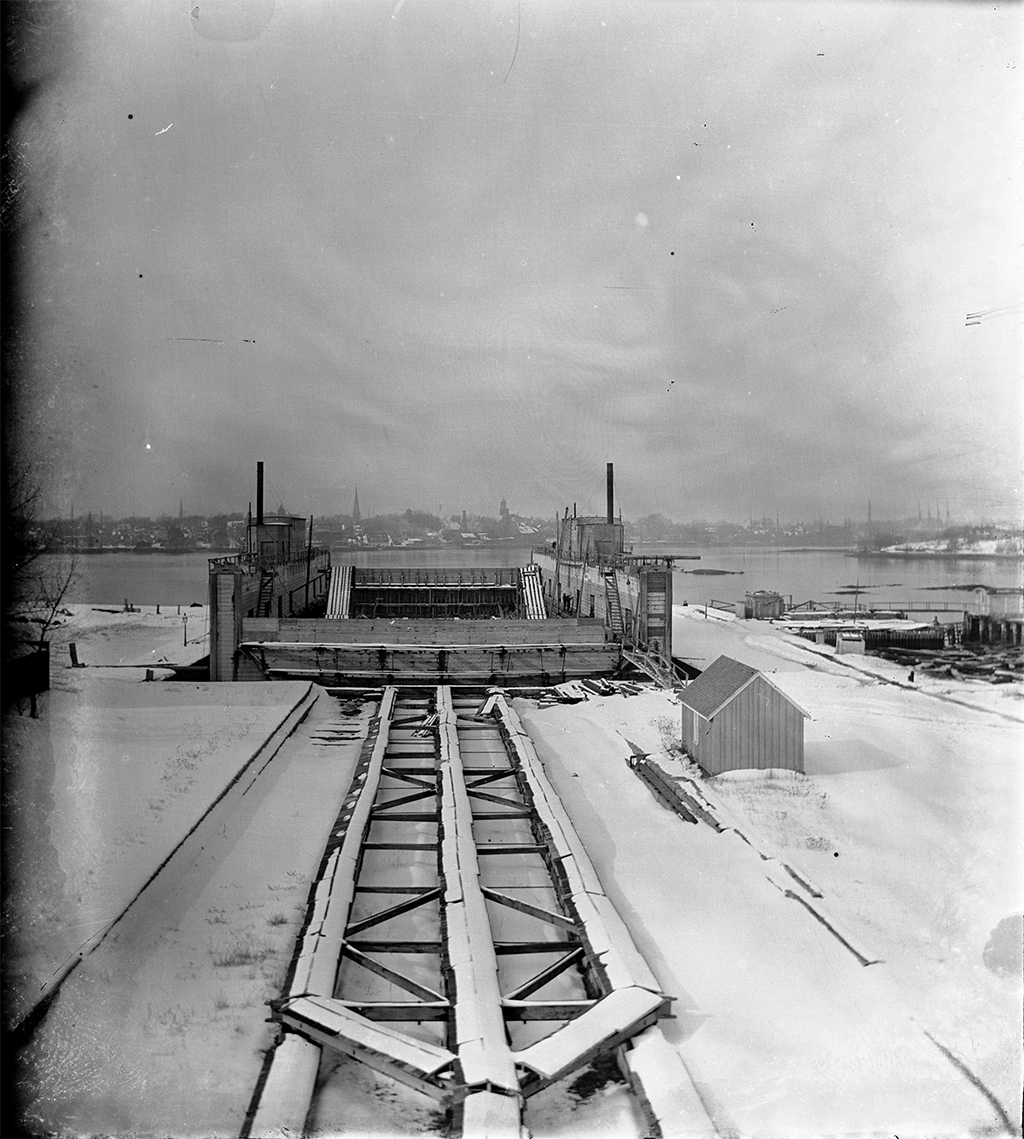
The next two glass plate photographs provide us with clear, close-up images of both Constitution‘s bow and stern (below). The dark lines on the lower hull is tar that was used to “pay” or seal the seams between the planks. The photograph of her starboard bow belies the Manchester Union reporter’s rosy description that there were “no signs of the vessel decaying”. The photograph reveals, with more detail than ever seen before, that an extra layer of hull sheathing supported by furring strips, had been installed between the bottom of the barn and the top of the waterline, presumably to keep the ship tight. The stern image gives a great view of the porch that had been built off the back of the barn and the steps to the catwalk onto the roof of the barn.
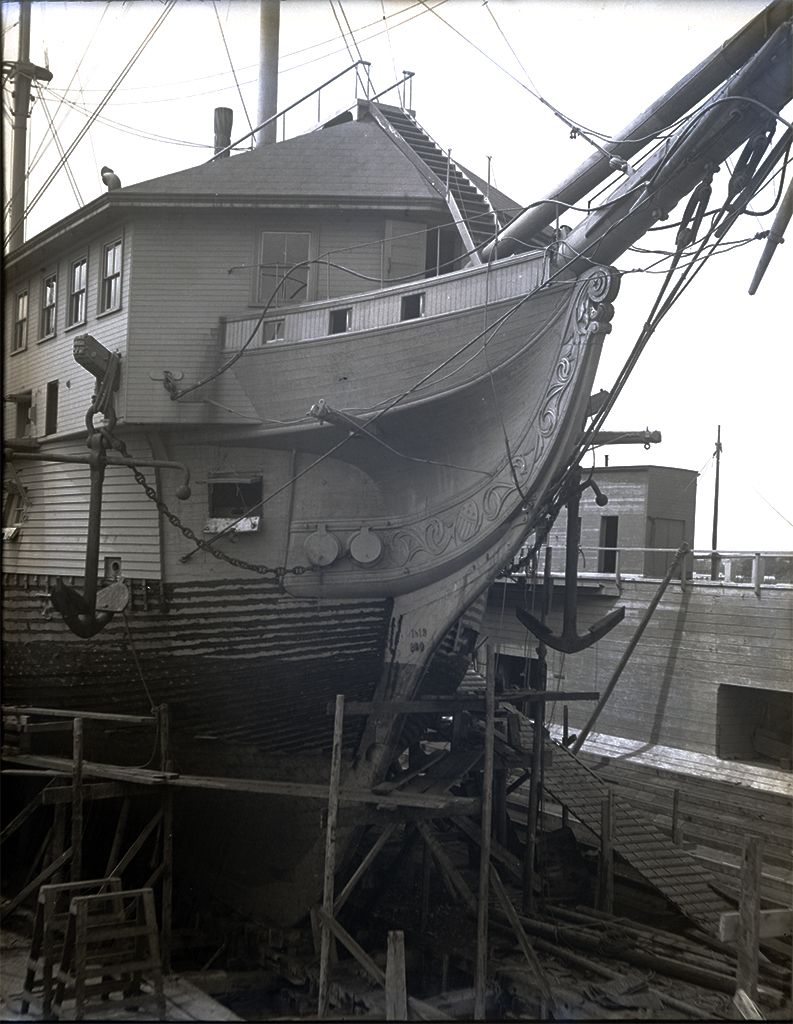
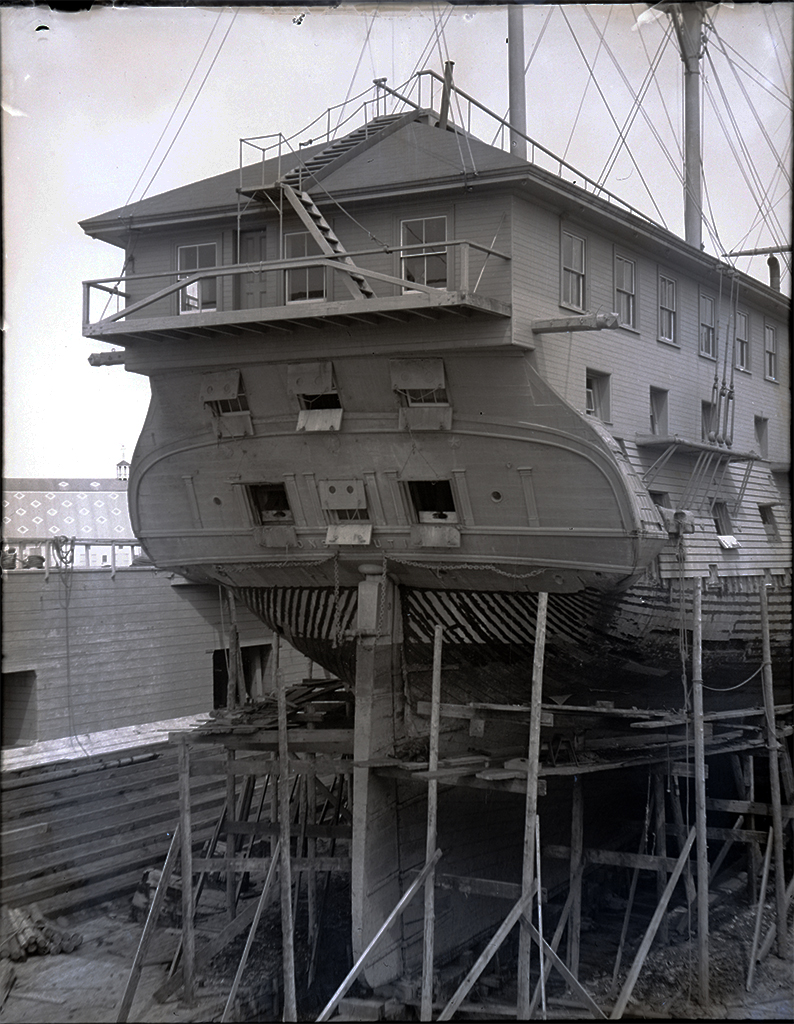
According to the logs of the Portsmouth Naval Shipyard, Constitution entered the balanced floating dry dock on July 19, 1897, at 3:15 p.m. She was floated out of the dock on July 21st at 11:25 a.m. The Annual Report of the Chief of the Bureau of Construction and Repair to the Secretary of the Navy for the Fiscal Year Ending June 30, 1898, noted under the section for the “Navy-Yard, Portsmouth, N.H.”:
“U.S.S. Constitution — The work done on this vessel consisted only of the repairs necessary to enable the ship to be towed to Boston for exhibition at the centennial of her launching, October 21, 1897.”
The glass plate photographs make it clear that the work on Constitution consisted only of enough caulking to prevent the ship from taking on too much water and sinking on her “homeward bound” voyage to Boston.
USS Leyden was launched in 1865, a steam-powered yard tug first assigned to the Boston (Charlestown) Navy Yard from 1866 to 1879. In 1879 she was reassigned to Portsmouth for the same duties. In 1897, Leyden was again reassigned to Newport, Rhode Island. Before that move and possibly as her last duty out of Portsmouth, she left for Boston at 1:28 p.m. on September 20th with Constitution in tow.
“Hundreds of spectators lined the water front here to-day to witness the departure of the historic United States frigate Constitution for Boston. The United States tug Leyden and the tug Piscataqua took the old ship in tow at 1:50 p.m. The Constitution left the navy yard amid the tooting of whistles, the cheering of the crowds, and a salute fired by enthusiastic citizens. The Constitution was in command of Boatswain Haley, with thirty men on board. Capt. Very, who is in command of the expedition to Boston, will release a carrier pigeon every ten miles, to convey information of the progress of the vessel. It is expected that the vessel will reach Boston to-morrow noon.” [“THE CONSTITUTION AT SEA. Last Voyage of the Famous Old Frigate Begun.”, The New York Times, dateline Portsmouth, N.H., September 20, 1897]
While photographs of USS Constitution under tow to Boston between September 20th and 21st have yet to be discovered, we are fortunate to have an image of “Old Ironsides” and USS Leyden at the wharf at the Portsmouth Naval Shipyard (below).
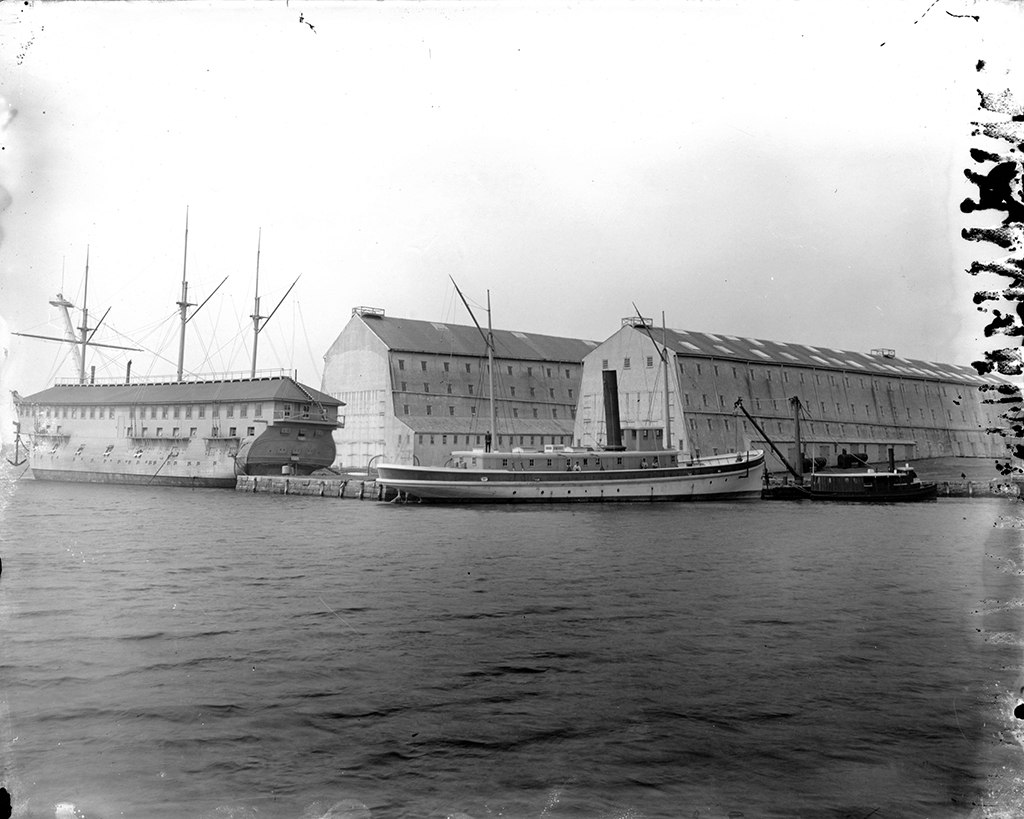
USS Constitution‘s last “expedition” of the 19th century was a success. She arrived safely at the Charlestown Navy Yard as planned on September 21, 1897, exactly a month before the 100th anniversary of her launch. Despite the Navy’s benign neglect shown to her during her fifteen years at the Portsmouth Naval Shipyard, Constitution once again proved that her “iron sides” could endure.
Boston’s celebrations honoring USS Constitution on October 21, 1897 were grand, indeed. Schools closed in celebration, parades wended their way through the rainy Boston streets, and addresses by prominent politicians were made at the official gathering at the Old South Meeting House.
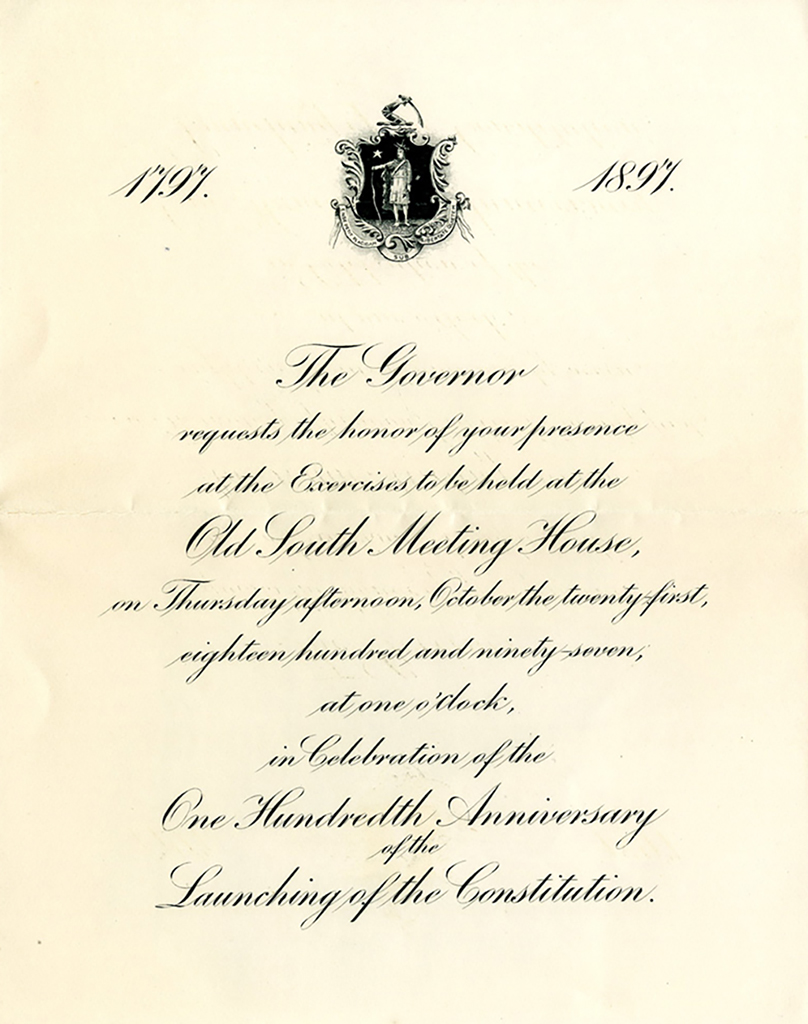
Befitting the occasion, Assistant Secretary of the Navy Theodore Roosevelt, a Harvard graduate and author of The Naval War of 1812, addressed the natural links between Massachusetts’ history and the ship’s history. He strongly emphasized the grand symbolism of “Old Ironsides'” record and the importance of preserving her for future generations.
“Massachusetts’ share in our national heritage of glorious memories has ever been great; and it is fitting that the most famous ship in our navy — the ship which has seen a century of honorable peace and yet more honorable war — should be connected by peculiar ties with Massachusetts and yet should by her very name emphasize the fact that the golden renown of her glory belongs to the whole Union. For every feat of lofty courage or iron endurance done or suffered by any American is from that moment part of the imperishable stock of memories and traditions of all Americans, whether they live on the Atlantic or the Pacific, in sight of the ocean surf or hundreds of leagues from any navigable water.” [Speech delivered by Theodore Roosevelt, October 21, 1897]
_____
The activity that is the subject of this blog article has been financed in part with Federal funds from the National Maritime Heritage Grant program, administered by the National Park Service, U.S. Department of the Interior, through the Massachusetts Historical Commission, Secretary of the Commonwealth William Francis Galvin, Chairman. However, the contents and opinions do not necessarily reflect the views or policies of the Department of the Interior, or the Massachusetts Historical Commission, nor does the mention of trade names or commercial products constitute endorsement or recommendation by the Department of the Interior, or the Massachusetts Historical Commission.
The Author(s)
Margherita Desy, Historian, Naval History and Heritage Command Detachment Boston
Historian, Naval History and Heritage Command
Margherita M. Desy is the Historian for USS Constitution at Naval History and Heritage Command Detachment Boston.
